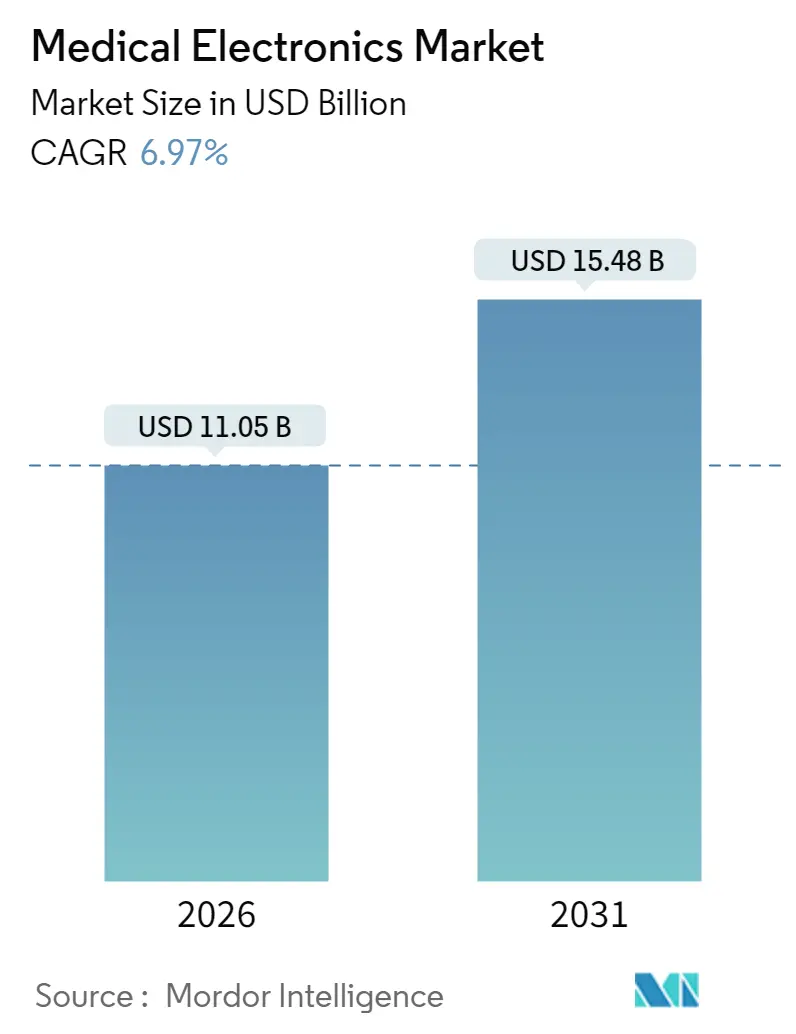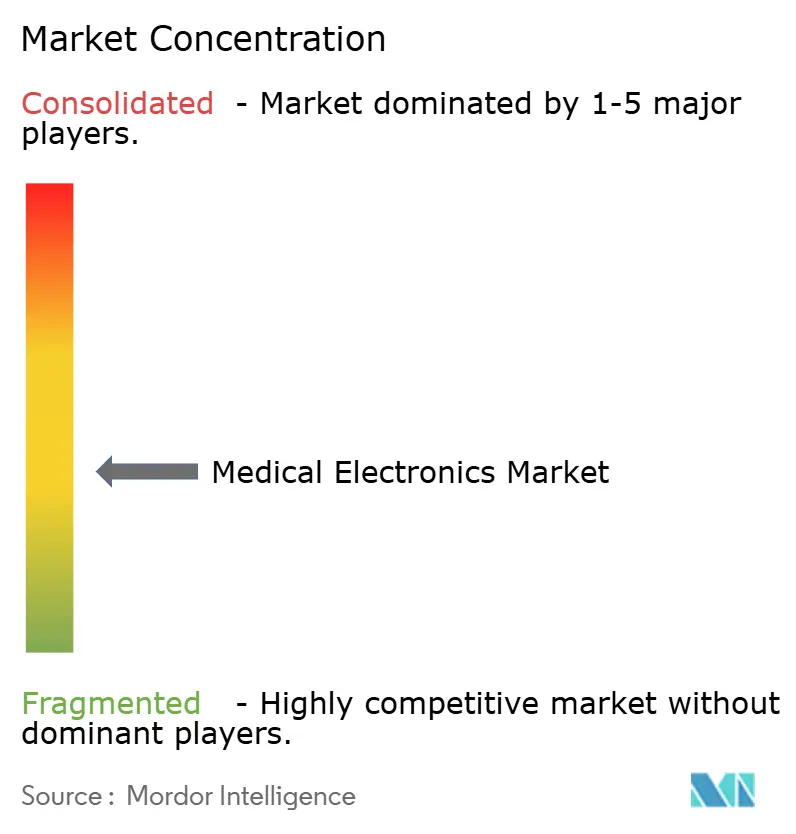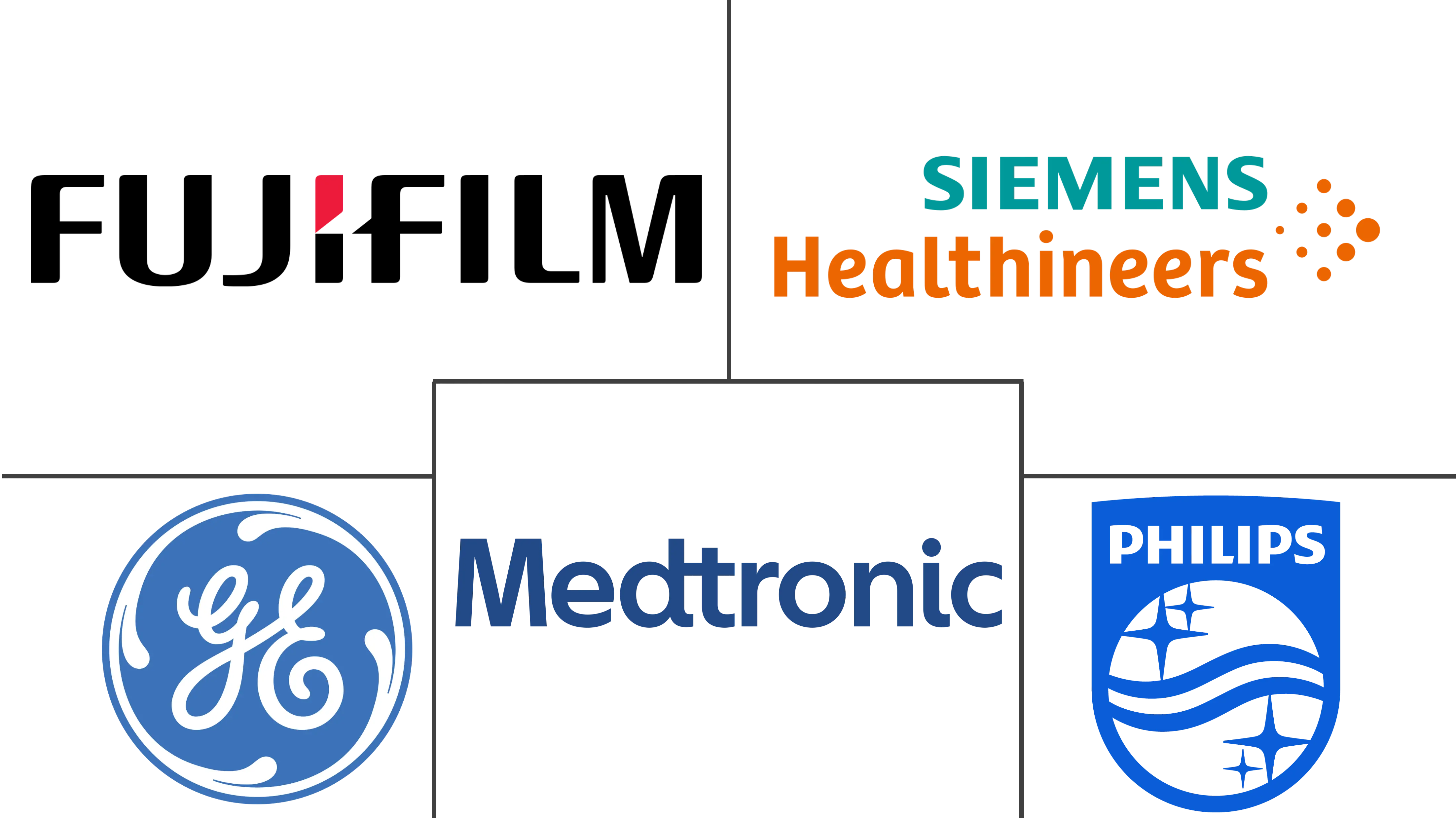Medical Electronics Market Size and Share

Medical Electronics Market Analysis by Mordor Intelligence
The Medical Electronics market is expected to grow from USD 10.33 billion in 2025 to USD 11.05 billion in 2026 and is forecast to reach USD 15.48 billion by 2031 at 6.97% CAGR over 2026-2031.
The expansion is propelled by regulatory modernization, the rapid shift toward hospital-at-home models that lower care costs by 30%, and accelerated adoption of AI-enabled diagnostics and monitoring solutions. Demand intensifies as nearly 20% of the global population will be 60 or older by 2030, creating sustained requirements for continuous, decentralized care. Semiconductor supply instability and tightening cybersecurity rules temper growth yet simultaneously stimulate supplier diversification, near-shoring, and product redesign. Asia-Pacific leads with a 17.79% CAGR, North America maintains technology leadership under new FDA cybersecurity mandates, and Europe balances innovation with complex compliance demands.
Key Report Takeaways
- By product, non-invasive devices led with 61.12% of medical electronics market share in 2025, whereas wearable and patch-based devices are projected to expand at a 12.94% CAGR through 2031.
- By application, monitoring captured 14.25% growth, outpacing diagnostics 46.05% revenue share in 2025.
- By end user, hospitals and clinics held 55.10% of the medical electronics market size in 2025, while home healthcare is forecast to rise at 14.55% CAGR to 2031.
- By geography, Asia-Pacific represented the fastest-growing region at 17.55% CAGR, while North America commanded 33.49% revenue share in 2025.
Note: Market size and forecast figures in this report are generated using Mordor Intelligence’s proprietary estimation framework, updated with the latest available data and insights as of January 2026.
Global Medical Electronics Market Trends and Insights
Drivers Impact Analysis
| Driver | (~) % Impact on CAGR Forecast | Geographic Relevance | Impact Timeline |
|---|---|---|---|
| Increasing Geriatric Population | +1.8% | Global; highest in North America, Europe, Japan | Long term (≥ 4 years) |
| Widespread Adoption of Diagnostic Imaging Technologies | +1.2% | North America and EU lead; rapid uptake in Asia-Pacific | Medium term (2-4 years) |
| Technological Advances in Sensor Miniaturization | +1.5% | Global; major R&D hubs in United States, Germany, Japan | Medium term (2-4 years) |
| Rising Prevalence of Chronic Diseases | +1.4% | Global; most acute in developed markets | Long term (≥ 4 years) |
| Integration of AI and Edge Analytics | +0.9% | Early adoption in North America and EU; expanding in Asia-Pacific | Short term (≤ 2 years) |
| Emergence of Hospital-At-Home Care Models | +0.7% | North America leads; pilot programs in EU | Medium term (2-4 years) |
| Source: Mordor Intelligence | |||
Increasing Geriatric Population
An expanding senior demographic elevates lifetime treatment needs and multiplies demand for non-invasive cardiac and metabolic monitoring. Nearly 80% of older adults live independently, prompting uptake of remote sensors that relay real-time vitals to clinicians. Miniaturized patches such as Medical Blackbox platforms deliver automated alerts that match seniors’ usability constraints. As governments prioritize “aging-in-place” strategies, device makers continue refining battery life, intuitive interfaces, and fall-detection algorithms to meet long-term home-care needs.
Widespread Adoption of Diagnostic Imaging Technologies
FDA clearance of AI tools like CLAIRITY BREAST, which forecasts five-year breast-cancer risk from routine mammograms, illustrates a diagnostic paradigm moving toward predictive medicine. GE Healthcare invests over USD 1 billion yearly in AI-enabled imaging, adding applications such as Flyrcado for myocardial perfusion scans.[1]GE Healthcare, “GE Healthcare Reports First-Quarter 2025 Results,” gehealthcare.com Forthcoming 6G networks aim to transmit radiology files instantly across cloud platforms, improving report turnaround and cutting repeat scans. Providers shift capital budgets into imaging suites that integrate algorithmic triage, lowering per-patient procedure cost while raising throughput.
Technological Advances in Sensor Miniaturization
The world’s smallest bioresorbable pacemaker, developed by Northwestern University, shows how sub-millimeter electronics unlock therapies that traditional form factors cannot deliver.[2]Northwestern University, “Bio-resorbable Miniature Pacemaker Demonstrated in Preclinical Studies,” northwestern.edu MEMS pressure sensors now enable consumer-grade wearables to achieve ≥99% accuracy in blood-pressure trending. Smart patches incorporating micro-fluidic drug reservoirs automate cardiovascular therapy based on live hemodynamic data. Self-assembling conductive polymers slash assembly steps, shortening product cycles and boosting reliability.
Rising Prevalence of Chronic Diseases
Chronic illnesses drive most healthcare spending in high-income economies, compelling hospitals to embrace value-based care contracts. Medtronic’s FDA-approved Inceptiv closed-loop spinal-cord stimulator adjusts current in real time using biological feedback, illustrating demand for adaptive therapeutics.[3]Medtronic plc, “Medtronic Announces Fiscal 2025 Results,” medtronic.com Fifth-generation (5G) network slicing raises bandwidth reliability so clinicians can depend on 24/7 telemetry without packet loss. These economics position continuous monitoring as a frontline strategy to reduce emergency admissions and medication non-compliance.
Restraints Impact Analysis
| Restraint | (~) % Impact on CAGR Forecast | Geographic Relevance | Impact Timeline |
|---|---|---|---|
| Stringent Regulatory Frameworks | -1.2% | Global; intensity varies by region | Medium term (2-4 years) |
| High Upfront Investment and Maintenance Costs | -0.8% | Global; especially challenging in emerging markets | Long term (≥ 4 years) |
| Volatility in Semiconductor Supply Chains | -0.9% | Global; manufacturing concentrated in Asia-Pacific | Short term (≤ 2 years) |
| Rising Cybersecurity & Data Privacy Compliance Costs | -0.6% | North America and EU lead new requirements | Medium term (2-4 years) |
| Source: Mordor Intelligence | |||
Stringent Regulatory Frameworks
FDA rules effective October 2023 require every connected device to include a cybersecurity management plan, a software bill of materials, and post-market vulnerability processes. Compliance fees and longer review cycles raise barriers for start-ups and stretch R&D budgets of mid-tier firms. In parallel, the EU MDR 2017/745 extends submission timelines by 12–18 months for many applicants, concentrating approvals among large manufacturers with global regulatory departments.
High Upfront Investment and Maintenance Costs
Building an advanced semiconductor foundry for medical electronics can exceed USD 1 billion, while ongoing US or EU operating expenses sit 10–35% higher than Asian peers. Supply-chain disruptions elevate freight costs by up to 20% and require strategic buffer stock, lifting working-capital needs. Talent shortages in micro-fabrication and firmware engineering widen wage premiums and lengthen recruitment cycles.
Segment Analysis
By Product: Non-Invasive Dominance Drives Innovation
Non-invasive devices delivered 61.12% medical electronics market share in 2025 as clinicians favored painless diagnostics that lower infection risk. MRI, CT, and X-ray platforms now bundle AI engines that automatically flag anomalies and reduce radiation exposure. The medical electronics market size for wearable and patch-based devices is projected to advance at 12.94% CAGR, supported by battery-sipping chipsets and FDA pathways for over-the-counter consumer use.
Invasive solutions maintain strategic importance for rhythm management, pain therapy, and endoscopy when non-invasive alternatives remain inadequate. Implantable loop recorders support cardiac monitoring for up to three years, while emerging resorbable pacemakers promise postoperative device-free recovery. Real-time closed-loop stimulators such as Inceptiv personalize therapy currents and extend battery life through adaptive algorithms. Procedural complexity and sterility requirements temper volumetric growth yet secure enduring demand in specialized surgical suites.

Note: Segment shares of all individual segments available upon report purchase
By Application: Monitoring Surges Past Traditional Diagnostics
Diagnostics commanded 46.05% revenue in 2025, but monitoring applications are forecast to expand 14.25% annually as payers incentivize early-warning systems that cut readmissions. The medical electronics market size for hospital-at-home monitoring is rising in lockstep with reimbursement codes covering remote vital-sign collection.
Integration of AI-enabled algorithms blurs boundaries between detection and prevention, with tools like CLAIRITY BREAST simultaneously screening and risk-scoring. Therapeutic devices merge with sensors to create drug-delivery patches that administer medication only when biometrics cross thresholds. Continuous glucose monitors, cardiac telemetry, and mobile spirometers illustrate how always-on surveillance replaces episodic lab visits, improving adherence and long-term outcomes.
By End User: Home Healthcare Transforms Care Delivery
Hospitals and clinics purchased 55.10% of all equipment in 2025, reflecting their central role in acute interventions and capital procurement. Yet home settings are forecast to post 14.55% CAGR as broadband penetration and 5G coverage enable physician-grade oversight outside traditional facilities. Nearly 80% of seniors prefer to age in place, creating a pull market for voice-guided blood-pressure cuffs and automated fall-detection wearables.
Ambulatory surgical centers deploy compact imaging and electrosurgical tools to shift low-complexity procedures from hospitals, decreasing overhead and patient stay. Long-term care and rehabilitation providers adopt smart beds and wireless vital monitors to offset staffing shortages and satisfy regulatory quality metrics. The medical electronics industry is thereby reconfiguring around distributed care nodes connected through secure, cloud-native dashboards.

Note: Segment shares of all individual segments available upon report purchase
Geography Analysis
Asia-Pacific records the fastest trajectory at 17.55% CAGR due to supportive industrial policy, rising middle-class healthcare spending, and rapid hospital construction. Venture funding receded during 2024, yet domestic accelerators and public grants continue to underwrite AI-enabled imaging start-ups that tailor products to regional epidemiology and price points.
North America retains 33.49% revenue leadership, aided by predictable FDA review pathways and strong early-adopter provider networks. Proposed semiconductor tariffs could lift input costs for more than half of US-registered devices, but near-shoring to Mexico, now the largest exporter of medical instruments to the United States, blunts longer-term supply-risk exposure. The medical electronics market size in North America benefits from hospital-at-home pilots that demonstrate 30% cost reduction and motivate payer coverage expansion.
Europe shares a sizable presence, balancing advanced R&D clusters with rigorous compliance regimes. EU MDR increases dossier complexity, yet initiatives such as Germany’s Digital-Health-Applications framework broaden reimbursement for connected devices. Sustainability directives favor energy-efficient imaging suites and circular-economy packaging, encouraging manufacturers to redesign product lifecycles. Regional growth remains steady as aging populations demand multi-pathology management and governments invest in digital records interoperability.

Competitive Landscape
The medical electronics market is competitive with the presence of a large number of several major players. Consolidation is a defining theme as leading firms buy niche innovators to accelerate portfolio renewal. Stryker closed a USD 4.9 billion deal for Inari Medical in June 2025 to broaden its peripheral-vascular franchise stryker.com. Globus Medical acquired Nevro for USD 250 million, adding pain-stimulation technology to its spinal-implant line. Boston Scientific’s 20.9% revenue jump in Q1 2025 highlights how targeted cardiovascular launches can capture share in crowded segments.
Technology differentiation centers on AI engines, embedded cybersecurity, and cloud interoperability. GE Healthcare allocates more than USD 1 billion each year to AI-enabled imaging and secured data pipelines, positioning its Edison platform at the heart of smart-hospital architectures. Medtronic plans to spin off its diabetes division to sharpen focus on neuromodulation and cardiac rhythm, while maintaining USD 33.5 billion revenue scale. Emerging challengers such as Epiminder secured FDA breakthrough status for the first implantable continuous EEG monitor, underscoring how specialized innovation can bypass entrenched incumbents.
Cybersecurity regulation is now a competitive lever. Firms with certified secure-by-design processes accelerate approvals and strengthen customer trust. Component scarcity pushes vertically integrated giants to lock in silicon supply through multiyear wafer agreements, disadvantaging smaller peers that buy on spot markets. Overall, the medical electronics market features medium concentration as top five players command roughly 45% combined revenue, leaving room for agile entrants to disrupt high-growth subsegments with differentiated AI algorithms or novel form factors.
Medical Electronics Industry Leaders
Koninklijke Philips N.V.
Siemens Healthcare GmbH
Fujifilm Corporation
Medtronic
GE Healthcare
- *Disclaimer: Major Players sorted in no particular order

Recent Industry Developments
- June 2025: Stryker completed its USD 4.9 billion acquisition of Inari Medical, providing entry into the high-growth peripheral vascular segment and expanding its neurovascular capabilities to address venous thromboembolism treatments affecting up to 900,000 lives annually in the United States.
- May 2025: Medtronic reported strong fiscal year 2025 results with USD 33.5 billion in revenue, a 3.6% increase, and announced plans to separate its Diabetes business into a standalone public company while projecting 5% organic revenue growth for fiscal 2026.
- April 2025: Boston Scientific announced Q1 2025 results with USD 4.663 billion in net sales, a 20.9% increase year-over-year, driven by strong performance in cardiovascular (26.2% growth) and urology (23.5% growth) segments.
- February 2025: Teleflex announced acquisition of BIOTRONIK's Vascular Intervention business for approximately EUR 760 million, enhancing its interventional portfolio in the USD 10 billion interventional cardiology and peripheral vascular market.
Research Methodology Framework and Report Scope
Market Definitions and Key Coverage
Mordor Intelligence defines the medical electronics market as the aggregate value of active electronic components and embedded circuits that power diagnostic imaging systems, patient-monitoring platforms, therapeutic devices, and portable or home-care equipment used for human healthcare worldwide. The valuation reflects factory-gate revenues recorded in the base year 2025, expressed in current USD.
Scope exclusions include non-electronic consumables, standalone software sold without bundled hardware, contract manufacturing revenues, and veterinary devices, which are not included.
Segmentation Overview
- By Product
- Non-invasive Products
- MRI
- X-Ray
- CT Scan
- Ultrasound
- Nuclear Imaging Systems
- Cardiac Monitors
- Respiratory Monitors
- Hemodynamic Monitors
- Multiparameter Monitors
- Digital Thermometers
- Wearable & Patch-based Devices
- Other Non-invasive Products
- Invasive Products
- Endoscopes
- Pacemakers
- Implantable Cardioverter-Defibrillators (ICD)
- Implantable Loop Recorders
- Spinal Cord Stimulators
- Other Invasive Products
- Non-invasive Products
- By Application
- Diagnostics
- Monitoring
- Therapeutics
- By End User
- Hospitals & Clinics
- Ambulatory Surgical Centers
- Home Healthcare Settings
- Other End Users
- By Geography
- North America
- United States
- Canada
- Mexico
- Europe
- Germany
- United Kingdom
- France
- Italy
- Spain
- Rest of Europe
- Asia-Pacific
- China
- Japan
- India
- Australia
- South Korea
- Rest of Asia-Pacific
- Middle East & Africa
- GCC
- South Africa
- Rest of Middle East & Africa
- South America
- Brazil
- Argentina
- Rest of South America
- North America
Detailed Research Methodology and Data Validation
Primary Research
Interviews and pulse surveys were conducted with biomedical engineers at hospitals, procurement heads at group purchasing organizations, component vendors, and regional regulators across North America, Europe, Asia-Pacific, and Latin America. Their insights validated utilization rates, service-contract attach ratios, and upcoming regulatory milestones, which were then folded back into our model to tighten assumptions.
Desk Research
Our analysts first mapped the universe through public datasets such as US FDA 510(k) clearances, WHO Global Health Expenditure, OECD Health Stats, UN population tables, and International Trade Center shipment codes that isolate HS-level flows for imaging and monitoring equipment. Company 10-Ks, investor decks, and selected peer-reviewed journals furnished average selling prices and replacement cycles, while D&B Hoovers and Dow Jones Factiva supplied supplemental financials and deal news. These sources establish the structural demand pool and price corridors that anchor the model. The list above is illustrative; numerous other credible publications were consulted for cross-checks and clarification.
Market-Sizing & Forecasting
A top-down reconstruction layers national procedure volumes, installed-base audits, and import-export tallies, which are then reconciled with selective bottom-up snapshots such as supplier roll-ups and sampled ASP × unit flows for MRI, CT, and multiparameter monitors. Key variables like aging-population share, chronic disease prevalence, hospital capital-expenditure cycles, component price erosion, and device approval pipelines drive yearly estimates. Multivariate regression links these indicators to historical revenue to project 2026-2030 growth, while scenario analysis stresses high inflation or delayed procurement cases. Where bottom-up evidence is thin, variance caps derived from component cost trends limit over or under-statement.
Data Validation & Update Cycle
Outputs pass a two-step analyst peer review, with automated anomaly flags for outliers beyond ±8%. Material deviations trigger re-contact with sources. Reports refresh annually, and an interim scan is run when major recalls, reimbursement shifts, or geopolitical events could sway demand.
Why Mordor's Medical Electronics Baseline Earns Decision-Maker Confidence
Published market values often diverge because firms differ in scope choices, pricing assumptions, and update cadence.
Key gap drivers include whether implantables and semiconductor revenues are folded in, how currency conversions handle recent volatility, and if service contracts are recognized alongside hardware. Mordor's model sticks to end-device electronics only, applies transaction-date FX rates, and refreshes every twelve months, producing a balanced, transparent baseline that buyers can readily trace.
Benchmark comparison
| Market Size | Anonymized source | Primary gap driver |
|---|---|---|
| USD 10.33 B (2025) | Mordor Intelligence | - |
| USD 172.4 B (2024) | Global Consultancy A | Counts semiconductor and contract manufacturing revenue; broad component scope inflates total |
| USD 6.0 B (2023) | Research Firm B | Narrow component set; older base year and constant-dollar forecast dampen value |
| USD 8.25 B (2024) | Trade Journal C | Excludes implantables and therapeutic devices; reliance on limited hospital spend surveys |
These comparisons show that our disciplined scope definition, variable selection, and rolling validation give stakeholders a dependable starting point for strategy and budgeting decisions.
Key Questions Answered in the Report
What is the current size of the medical electronics market and how fast is it growing?
The market stood at USD 11.05 billion in 2026 and is forecast to reach USD 15.48 billion by 2031, advancing at a 6.97% CAGR.
Which product category dominates sales in medical electronics?
Non-invasive devices hold 61.12% share, reflecting broad clinical and patient preference for painless diagnostics and monitoring.
Why is Asia-Pacific considered the fastest-growing region?
Supportive industrial policies, expanding middle-class healthcare spending, and infrastructure investment drive a 17.55% CAGR through 2031.
How are new FDA cybersecurity mandates affecting device makers?
Manufacturers must include a comprehensive cybersecurity management plan and software bill of materials in submissions, lengthening development timelines but creating competitive advantage for firms with robust security processes.
What role does AI play in shaping future medical electronics?
AI algorithms enhance diagnostic accuracy, enable predictive analytics, and integrate with edge computing, turning devices into intelligent platforms that support real-time clinical decisions.
Which end-user segment is expanding quickest?
Home healthcare is growing at a 14.55% CAGR as hospital-at-home models, aging-in-place preferences, and telehealth reimbursement foster demand for connected monitoring equipment.



